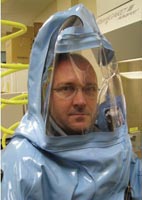
Keeping Cool in the Hot Zone
Every precaution is taken to safeguard researchers who work with the world's deadliest viruses.
- By Marc Barrera
- Jan 31, 2008
 Dr. Mike Holbrook, director of the
Robert E. Shope, M.D., Laboratory, a
Biosafety Level-4 lab at the University of
Texas Medical Branch at Galveston, deals
with some of the deadliest viruses known
to man, including Ebola, Marburg, Lassa,
Junin, and Nipah viruses. It goes without
saying that special precautions are put into
place to ensure total security and safety.
Dr. Mike Holbrook, director of the
Robert E. Shope, M.D., Laboratory, a
Biosafety Level-4 lab at the University of
Texas Medical Branch at Galveston, deals
with some of the deadliest viruses known
to man, including Ebola, Marburg, Lassa,
Junin, and Nipah viruses. It goes without
saying that special precautions are put into
place to ensure total security and safety.
Before entering a BSL-4 lab, entrants
must pass through a security checkpoint
that verifies they have all the proper credentials.
Once they’re inside the facility,
the security screening has just begun.
“Our building has many different levels of
security access stuff on the way in,” Holbrook
said. “All the floors are security
access, all the elevators, and so forth.”
Upon arriving at the BSL-4 lab,
researchers must first enter a “Clean
Change Room” in which they change out
of their street clothes and put on scrubs.
From there they enter the suit room to
don a positive-pressure suit. “You’ve
probably seen them on TV or on the
Web; they’re big, blue suits that we have
medical-grade breathing air pumped into
them,” Holbrook said.
When researchers are in the lab, one of
the first things they do at their stations is
connect to the air supply. The positive
pressure provides added safety for the
researcher, pushing air out in the event of a
tear or puncture in the suit, but the suit’s air
pressure is not without its risks. Holbrook
said there is a chance of dehydration.
“You figure, if you’re running 14
pounds of air through your suit continuously
for four or five hours, you
can get dehydrated pretty fast. So that’s
one of those things that we have to be
very careful about and pay attention
to,” he said.
Minimizing Puncture Hazards
Working with animals poses puncture
risks. “In that environment, you’re
working with something
that bites, and
especially if they’re
sick, they’re not very
happy. When working
with animals, we anesthetize
them before we
do anything,” Holbrook
said.
Handling sharp objects,
such as needles,
has its own hazards. To
minimize these risks,
no researchers use
scalpels or knives, and
all scissors are blunted
on one end. In addition,
before gaining access to
the lab, researchers
must first go through a
special training program
taught in a mock lab so they can get
used to moving around and working in
their suits. “It’s a new environment, and it
gives them a chance to get used to it before
they get into the hot zone,” said Holbrook.
Only after researchers have demonstrated a
significant aptitude for successfully
working in lower-level containment labs,
such as BSL-3, may they start training for
BSL-4, he said.
Clearing the Air
The suits are considered a last line of
defense behind several other safety tools
to prevent viral exposures. Enclosed
biosafety cabinets employ an inwarddirected
and HEPA-filtered air system to
prevent microbes from escaping. “People
ask, ‘Would you ever be worried about not
having your suit on in the lab?’ My answer
is no, because when people are working
properly everything is in the cabinet. The
cabinet is doing its job. The air in there is
clean,” he said.
If something were to be released outside
a biosafety cabinet—for example, if
someone dropped a virus culture on the
floor—Holbrook says it would be sucked
into the laboratory’s air filtration system,
which cycles through 15 to 20 complete
room air changes per hour. In this process,
air is screened through a double-HEPA
filtration system before being exhausted.
The air flow between these filters is continually
monitored by computer sensors
that alarm if the air flow through them
drops for any reason.
If a virus were to
make it through these
safeguards and exit
out of the building’s
stack, Holbrook said it
wouldn’t get far. “With
all the viruses we work
with in BSL-4, none of
them like the sun very
much, and none do
very well when they
get dehydrated,” he
said. “Even in our nice
humid environment
down here in Galveston,
if a virus particle
was shot out the top
of our chimneys, it
would survive maybe
six inches.”
Decon at Shift’s End
At the end of a work shift, researchers
exiting the BSL-4 lab go through an
eight-minute decontaminating shower,
which rinses the suit with chemicals and
water, before the suit may be removed.
From there, the researchers must take a
hot shower before donning their street
clothes and leaving.
The Robert E. Shope, M.D., Laboratory
is the only full-sized BSL-4 lab on a
university campus in the United States.
The Galveston National Laboratory,
UTMB’s second BSL-4 lab, is scheduled
for completion in June 2008.
This article originally appeared in the February 2008 issue of Occupational Health & Safety.